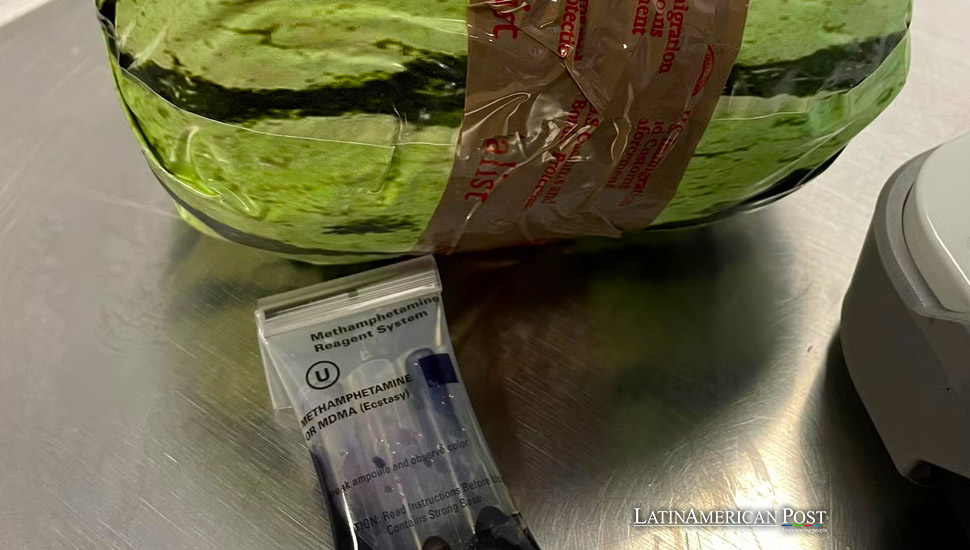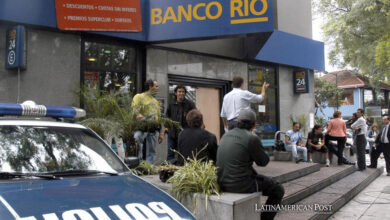Meth Disguised as Watermelons Uncovered at US-Mexico Border

U.S. border agents recently intercepted a truck carrying over $5 million worth of methamphetamine ingeniously disguised as watermelons at the US-Mexico border. This elaborate smuggling attempt underscores the lengths to which drug cartels will go to transport illicit substances into the United States.
A Startling Discovery at the
In a remarkable display of vigilance and expertise, U.S. Customs and Border Protection (CBP) agents at the Otay Mesa border crossing in California recently made a shocking discovery: over two tonnes of methamphetamine hidden inside a shipment of watermelons. The drugs, worth more than $5 million on the street, were meticulously wrapped in plastic and painted in two shades of green to resemble the fruit, making the deception nearly undetectable.
This seizure, which involved a staggering 1,220 packages of methamphetamine, highlights the lengths to which drug cartels are willing to go to smuggle their products into the United States. The elaborate disguise involving placing the fake watermelons among real ones represents one of many creative tactics traffickers employ to evade detection. The driver of the truck, who claimed to be transporting a legitimate load of produce, was apprehended and handed over to Homeland Security officials.
The Ingenious Methods of Drug Cartels
Drug cartels have long relied on creative and cunning methods to smuggle narcotics across international borders, and the use of produce shipments as a cover is a well-established tactic. Bananas, avocados, and even Gouda cheese have all been used to conceal illicit drugs in the past. However, this recent case involving methamphetamine disguised as watermelons is particularly notable for its level of detail and sophistication.
The drugs were carefully packaged to mimic the appearance of watermelons, blending seamlessly with the legitimate produce in the shipment. This attention to detail suggests the involvement of a highly organized and well-funded criminal operation. The discovery of such a large quantity of methamphetamine hidden in this manner underscores the ongoing challenge faced by border agents in detecting and intercepting drug shipments.
A Growing Trend of Methamphetamine Smuggling
The seizure at Otay Mesa is part of a broader trend of increasing methamphetamine smuggling attempts along the U.S.-Mexico border. Just a week before the watermelon bust, CBP agents at the same border crossing uncovered nearly 300 kilograms of methamphetamine hidden in a shipment of celery. Together, these two busts have a combined street value of approximately $6 million, highlighting the significant financial stakes involved in the drug trade.
Methamphetamine, commonly known as meth, is a powerful and highly addictive stimulant that has become a significant public health concern in the United States. Mexican drug cartels are the primary producers and suppliers of methamphetamine to the U.S. market, with the majority of the drug entering the country through land border crossings. The volume of methamphetamine being smuggled into the U.S. has increased dramatically in recent years, driven by the drug’s widespread availability and relatively low cost of production.
Mexico’s Role in the Methamphetamine Trade
Mexico’s role as a major producer of methamphetamine has grown significantly over the past decade. Powerful drug cartels, such as the Sinaloa Cartel and the Jalisco New Generation Cartel (CJNG), operate large-scale methamphetamine laboratories that produce vast quantities of the drug for export to the United States. These labs are often located in remote areas and are equipped with sophisticated machinery capable of making tonnes of methamphetamine in a relatively short period.
In February, Mexican authorities made headlines when they seized more than 40 tonnes of methamphetamine from what is believed to be the largest meth lab discovered in recent years. The lab, located in the state of Sinaloa, was equipped with over 200 centrifuges, boilers, and condensing chambers—essential equipment for methamphetamine production. The discovery of such a large and sophisticated operation highlights the scale of the methamphetamine problem in Mexico and the challenges faced by law enforcement in curbing its production and distribution.
The Devastating Impact of Methamphetamine on U.S. Communities
The influx of methamphetamine into the United States has had devastating consequences for communities across the country. Meth is a highly addictive drug that can cause severe physical and psychological harm to users. It is associated with a wide range of health issues, including heart problems, cognitive impairments, and mental health disorders. The drug’s impact on public health is further compounded by its contribution to crime, homelessness, and the burden on healthcare systems.
The availability of cheap, high-purity methamphetamine has led to a resurgence in its use, particularly in rural and economically disadvantaged areas. Law enforcement agencies across the U.S. have reported an increase in meth-related arrests, overdoses, and drug-related violence. The drug’s low cost and long-lasting effects make it an attractive option for individuals struggling with addiction, but it also poses significant challenges for treatment and recovery efforts.
The Role of U.S. Border Agents in the Fight Against Drug Trafficking
The work of U.S. border agents is critical in the ongoing fight against drug trafficking. Border crossings like Otay Mesa are on the front lines of this battle, with agents responsible for inspecting thousands of vehicles and shipments daily. The discovery of methamphetamine hidden among shipments of watermelons and celery underscores the need for advanced inspection technologies and the expertise of CBP officers.
In this particular case, a sniffer dog was instrumental in detecting the methamphetamine concealed in the celery shipment. Drug detection dogs are trained to identify specific narcotics’ scents, even when hidden within seemingly innocuous items. The success of this operation demonstrates the importance of combining human expertise with advanced technology in the fight against drug trafficking.
The Broader Implications of Drug Smuggling Operations
The persistence of drug smuggling operations, such as the recent watermelon bust, has far-reaching implications. Beyond the immediate threat to public health, the drug trade fuels violence and corruption on both sides of the U.S.-Mexico border. In Mexico, drug-related violence has claimed tens of thousands of lives over the past decade as cartels compete for control of lucrative smuggling routes and production territories. This violence often spills over into civilian areas, leading to widespread fear and instability.
In the United States, the economic and social costs of drug addiction are immense. The methamphetamine epidemic places a significant strain on law enforcement, healthcare providers, and social services. The fight against drug trafficking is not just about stopping the flow of narcotics; it’s also about addressing the root causes of addiction and providing support for those affected by the crisis.
International Cooperation and Future Challenges
Combating methamphetamine smuggling requires close cooperation between the United States and Mexico, as well as other international partners. Efforts to dismantle drug cartels and shut down methamphetamine production labs in Mexico are crucial for reducing the supply of the drug. At the same time, U.S. authorities must continue to enhance border security and improve their detection capabilities to prevent drugs from entering the country.
However, the challenge remains daunting. Drug cartels are constantly adapting their tactics to evade detection, and the sheer scale of the drug trade means that even significant seizures represent only a fraction of the total amount of methamphetamine being smuggled into the United States. As long as there is demand for the drug, cartels will continue to find ways to supply it.
The Ongoing Battle Against Drug Smuggling
The recent $5 million methamphetamine bust at the US-Mexico border, involving drugs disguised as watermelons, is a stark reminder of the ongoing battle against drug trafficking. While the seizure represents a significant victory for law enforcement, it also highlights the persistent challenge of combating drug smuggling operations that are becoming increasingly sophisticated.
The fight against methamphetamine and other narcotics requires a multifaceted approach involving law enforcement, public health initiatives, and international cooperation. As drug cartels continue to innovate their smuggling techniques, authorities must remain vigilant and adaptable in their efforts to protect communities from the devastating impact of illicit drugs.
Also read: U.S. Agents Battle Hidden Drug Mexico-China Networks
Ultimately, the goal is not just to intercept drug shipments but to address the underlying issues that drive the demand for methamphetamine and other narcotics. This includes providing support for addiction treatment and recovery, as well as addressing the social and economic factors that contribute to substance abuse. Only by tackling the problem at its roots can we hope to make lasting progress in the fight against drug trafficking.





